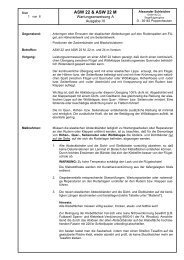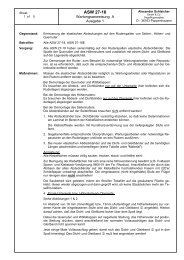18m: Vom Markt bestätigt - Alexander Schleicher
18m: Vom Markt bestätigt - Alexander Schleicher
18m: Vom Markt bestätigt - Alexander Schleicher
Create successful ePaper yourself
Turn your PDF publications into a flip-book with our unique Google optimized e-Paper software.
ASH 25 Mi<br />
ASH 25<br />
The ASH 25 is an Open Class two-seater with a variable span of 25 m, or with winglets fitted of 25.6 m and<br />
26 m respectively. The Mi-version as self-launching powered sailplane is fitted with a power-plant. The<br />
ASH 25 Mi uses a CRP / SRP (Kevlar) monocoque fuselage with roomy safety cockpit. The full-vision plexiglass<br />
canopies are hinged fore and aft and offer a comfortable entry for the pilots. The rubber-shock-mounted,<br />
retractable landing gear with a big 380 x 150 tire and hydraulic disc brake, the upwards hinging instrument<br />
panel in the front seat, and the infinitely variable speed trim, are only some of the many available conveniences.<br />
The 4-part wing with laminar airfoil and boundary layer control on the underside is built as a carbonfiber<br />
sandwich. The sophisticated control linkage system gives very good maneuverability and harmless flight characteristics.<br />
All control surface hinges use needle bearings or low-maintenance plastic bearings. The actuating<br />
levers and bellcranks are fitted with ball bearings or precise uniball-joints. This provides comfortable actuating<br />
forces for the pilot and guarantees non-fatiguing flying. With winglets fitted the span is increased to 25.6m and<br />
26m respectively.<br />
The reliable and compact power-plant conception by SCHLEICHER, using a rotary engine, has been<br />
equipped with a fuel injection system for the ASH 25 Mi. This together with the new developed propeller (also<br />
a <strong>Schleicher</strong> design) helped to upgrade yet further the so far outstanding performance data . It is not just a<br />
self-launcher, the optimized thrust power on ground as well as the good climb values in powered flight must<br />
also be pointed out. The advantages of the rotary engine regarding smooth running and low vibration are very<br />
effective not only with full throttle but also in the low performance range. This engine unit stands out for simple<br />
operation, very low noise emission also in the cockpit, quick assembly and re-assembly, as well as low fuel<br />
consumption.
ASH 25 Mi<br />
Our advertising for the start of ASH 25 serial production:<br />
Two seater of a new dimension<br />
Flying Open Class Competitions in a two-seater? The ASH 25,<br />
being the series production version of the AS 22-2, offers outstanding<br />
performance and on top of that the advantage of a<br />
second pilot.<br />
The new wing - the airfoil was modified in the aileron area and<br />
the span was increased to 25 m - demonstrates outstanding<br />
performance not only in the high speed range, but also in low<br />
speed and -particularly important - in circling flight. The new<br />
wing layout allows narrow circle even with high wing loading, as<br />
the maximum lift of the entire wing is used also in circling flight.<br />
Being made almost exclusively out of carbon and aramid fibers<br />
(Kevlar), this high performance glider offers adequate useful<br />
load, sufficient for even two heavier pilots. Likewise the permissible<br />
C.G. range was selected such that also different cockpit<br />
loads present no problem.<br />
The ASH 25 can be flown two-seated up to a take-off mass of<br />
750 kg (1654 lb.) and in this configuration the water ballast affects<br />
the C.G. position only imperceptibly.<br />
2<br />
But also for weak weather conditions the ASH 25 offers an adequate<br />
wing loading with m/S = 38 kg/m² (two-seated). The experience<br />
with the ASW 22 has shown that a glider with an aspect<br />
ratio of over 37 requires more wing loading than a 15 m<br />
glider.<br />
The flight testing of the AS 22-2 has demonstrated that the impressive<br />
flight characteristics of the ASW 22 can be transferred<br />
to a two-seater. The wing with its HQ17 airfoil and its flap kinematik<br />
provides comfortable and safe characteristics; for example<br />
this flap mixer system permits extremely steep and easily<br />
controllable landing approaches and the stick forces are low.<br />
The landing gear, high and sprung, as well as the larger dihedral<br />
of the wing help to the good landing characteristics.<br />
Despite of some changes compared to the AS 22-2 fuselage,<br />
the fuselage shape of the ASH 25 still discloses the affinity to<br />
the fs 31 made by the Akaflieg Stuttgart. This fuselage geometry<br />
with its contracted tail boom stands out for relatively low<br />
aerodynamical drag. So the goal is achieved: to develop a twoseater<br />
which offers comfortable room for two pilots, without any<br />
significant performance loss compared to a single-seater.<br />
Today we do not talk any longer about a "new" dimension; it is meanwhile more than 240 ASH 25 aircraft<br />
which you may come across all over the world. Today this aircraft is on the top place in the list of wishes of a<br />
glider pilot's dream.<br />
This aircraft not only has revived the competitions for the Open Class, but in some gliding clubs it also allowed<br />
the training of real competition flying. Only very few of our ASH 25 were involved in serious accidents,<br />
so our philosophy of „active safety“ has been confirmed. Some units of our ASH 25 have already exceeded a<br />
service life 3000 hours, without technical problems, and meanwhile approach the 6000 hours without any<br />
problems. Signs of quality and reliability.<br />
As at the beginning of its design our ASH 25 is now as before up to date, and together with the power-plant<br />
system of the ASH 26 E it offers to you a self-launching glider of the future - the ASH 25 Mi.
DESIGN SPECIFICATION<br />
ASH 25 Mi<br />
Glider, midwing configuration with T-tail, flaps, retractable landing gear and water ballast.<br />
FUSELAGE CRP / SRP (Kevlar) monocoque fuselage with roomy safety cockpit. Rubber-shock-mounted, retractable<br />
landing gear with 380 x 150 tire, retraction mechanism has counter spring for ease of operation.<br />
Hydraulic disc brake which is connected to the airbrake lever. In flight adjustable rudder<br />
pedals. Optimum cockpit ventilation through intake in the fuselage nose with continuously adjustable<br />
outlets, one on the front canopy frame and the others through directionally-adjustable fresh air<br />
nozzles for both pilots. TOST C.G. tow release coupling. TOST aero tow release coupling as optional<br />
extra on request. Infinitely variable speed trim, lockable by a stick key.<br />
CANOPIES The full-vision plexiglass canopies are hinged fore and aft (same system as ASK 21). The two-part<br />
canopy system was chosen because it gives the advantage of an excellent fit and tight sealing with<br />
all temperatures. On the left side sliding window with additional airscoop. Canopy frame with<br />
tongue and groove type sealing.<br />
INSTRUMENT PANELS The front instrument panel is made to hinge upwards with the canopy; even when the canopy is<br />
open, the instruments are still covered. When the canopy emergency jettison system is operated,<br />
the canopy together with the instrument panel coaming can be removed and the instruments are<br />
easily accessible. The rear instrument panel is not hinged to the canopy, but offers sufficient leg<br />
room for a safe emergency exit.<br />
WING Cantilever, four-part wing with new developed laminar airfoil and boundary layer control at the wing<br />
underside. The wing surface is a sandwich of carbon fiber / plastics with a hard foam core; wing<br />
spars with carbon fiber flanges. Metal dive brakes on the upper wing side (airbrake paddles with<br />
spring-loaded caps). Pushrods sealed by bellows. Wing assembly is straightforward with a conventional<br />
tongue and fork spar extension secured with two large, easily insertable, cylindrical main<br />
pins. Relatively low weight of each wing part. No wing part is heavier than those of 15 m Class<br />
gliders.<br />
.<br />
WATERBALLAST Waterballast system with automatic connections. Easy maintenance because of removable waterbags.<br />
Filling through two drain outlets under the wing. Ballast capacity: approx. 2 x 60 kg in the<br />
outer wing.<br />
TAILPLANE AND<br />
FLAPS T-tail (elevator with stabilizer). Stabilizer in CRP-sandwich-construction. Vertical fin in GRPsandwich<br />
construction because of the VHF-antenna radiation. All control surfaces & flaps are newtechnology<br />
sandwiches of Aramid fiber / plastics with a hard foam core; which gives extremely light<br />
and stiff control surfaces.<br />
CONTROL CIRCUITS AND<br />
FITTINGS Aileron, elevator, flaps, and airbrakes are actuated by pushrods running in anti-noise ball-bearings.<br />
Automatic elevator connection Quick-closing connectors without loose parts are fitted at the control<br />
linkage rigging points. The actuating levers and bellcranks are fitted with ball bearings and precise<br />
uniball-joints. This provides the lowest possible actuating forces for the pilot and guarantees comfortable,<br />
non-fatiguing flying. The rudder is actuated partly by rods and partly by steel cables. The<br />
fittings are welded steel and milled or turned Duraluminium respectively.<br />
BOARD EQUIPMENT AND<br />
ACCESSORIES Static pressure vents (for the A.S.I.) in the fuselage tail boom left and right. Pitot, static pressure<br />
and TE-compensation through 3-way-nozzle (multi-probe) in the fin. For the powered sailplane Pitot<br />
in the fuselage nose. VHF antenna in the fin. Flight monitoring instruments as required can be installed<br />
in the instrument panels. Threaded bushings at the canopy frame left & right for possible fixing<br />
of camera mountings. Seat cushion and storage pocket.<br />
POWER-PLANT The development of a new conception for the power-plant has solved many of the so far known<br />
problems with retractable engine units. The foldable drive belt makes it possible to install the engine<br />
stationary in the fuselage. This has a particularly positive effect for the size of the exhaust silencer.<br />
Furthermore, it provides a better mounting bedding of all components of the power-plant.<br />
The entire power-plant can be removed after undoing three bolted connections. The C.G. of the<br />
power-plant is below the front mounting attachment point which means that in the case of a crash<br />
landing the pilot is protected against the propeller tower. The power supply is provided by two batteries<br />
with a total of 14 Ah which are fitted in the inner wing.<br />
ENGINE Single rotor engine IAE 50R, with liquid cooled housing and with forced air rotor cooling. Electronic<br />
fuel injection system and dual electronic ignition, firing 2 plugs with electrical starting and 18 amp<br />
Generator.<br />
The rotary engine was developed by the renowned motorcycle manufacturer NORTON, Great Britain,<br />
and it is outstanding for its low power-to-weight ratio and its remarkable smooth running. The<br />
manufacturer has succeeded in solving typical "Wankel-type" problems. The seals are the latest<br />
state of the art technology and through the interior air cooling it was possible to solve the problem<br />
of the rotor overheat.<br />
3
ASH 25 Mi<br />
TECHNICAL DATA<br />
ASH 25 with Winglets with Winglets ASH 25 Mi with Winglets with Winglets<br />
Span m (ft) 25 (82,02) 25,6 (83,98) 26,0 (85,30 25 (82,02) 25,6 (83,98) 26,0 (85,30<br />
Wing area m² (sqft)<br />
16,31<br />
(175,56)<br />
16,46<br />
(177,17)<br />
<strong>Alexander</strong> <strong>Schleicher</strong> GmbH & Co. Segelflugzeugbau<br />
D-36163 Poppenhausen (Wasserkuppe) <strong>Alexander</strong>-<strong>Schleicher</strong>-Straße 1<br />
D-36161 Poppenhausen (Wasserkuppe) P.O. Box 60<br />
Tel. ++49 (0) 66 58 / 89-0<br />
Fax ++49 (0) 66 58 / 89 40<br />
e-mail: info@alexander-schleicher.de<br />
homepage: www.alexander-schleicher.de<br />
16,62<br />
(178.89)<br />
Design and construction subject to change without prior notice. Issue: July 2003<br />
16,31<br />
(175,56)<br />
16,46<br />
(177,17)<br />
16,62<br />
(178.89)<br />
Wing aspect ratio 38,32 39,82 40,67 38,32 39,82 40,67<br />
Fuselage length m (ft) 9 (29,52)<br />
Höhe (LW u. Heckrad) m (ft) 1,7 (5,57)<br />
Wing airfoils HQ 17 und DU 84-132/V3 at the wingtip<br />
Empty mass ( min.equipment) kg (lb)<br />
ca. 470<br />
(1036)<br />
ca. 478 (1053) ca. 484 (1067) ca. 580 (1278) ca. 588 (1296) ca. 594 (1309)<br />
Max. take-off mass kg (lb) 750 (1653,46) 790 (1741,6)<br />
Waterballast l (US gal) max. 120 (31.7)<br />
Max. wing loading (2-seated) kg/m² (lb/sqft) 46 (9,42) 45,6 (9,33) 45,1 (9,23) 48,4 (9,91) 48 (9,83) 47,5 (9,72)<br />
Min. wing loading (1-seated) kg/m² (lb/sqft) ~34 (6,96) ~34 (6,96) ~34 (6,96) ~40 (8.19) ~40 (8.19) ~40 (8.19)<br />
Max. speed km/h (kts) 280 (151) 285 (153.7)<br />
Min. speed km/h (kts) ca. 75 bei 555 kg (40,4 kts at 1224 lbs) ca. 81 bei 790 kg (43,7 kts at 1741 lbs)<br />
Min. sink m/s (ft/min) ca. 0,42 bei 34 kg/m² (82,67 at 6,96 lb/sqft) ca. 0,49 bei 48,4 kg/m² (96,5 at 9,91 lb/sqft)<br />
Best glide ratio<br />
Engine Unit:<br />
> 57 (95<br />
km/h)<br />
~60 ~60<br />
> 57 (95<br />
km/h)<br />
~60 ~60<br />
Performance kW - 41 (56 HP) at 7750 RPM<br />
Cubic capacity cm³ - 294



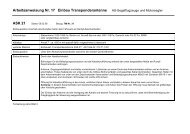


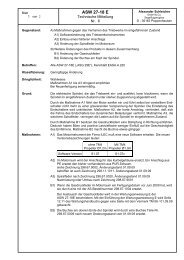
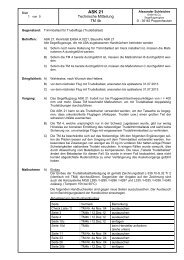
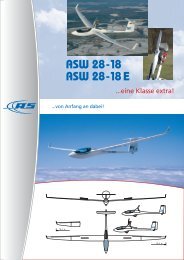



![AD 2012-0246 [PAD 12-122 task 2012.251] Schleicher-Ka6 K7 K8 ...](https://img.yumpu.com/8336662/1/184x260/ad-2012-0246-pad-12-122-task-2012251-schleicher-ka6-k7-k8-.jpg?quality=85)


